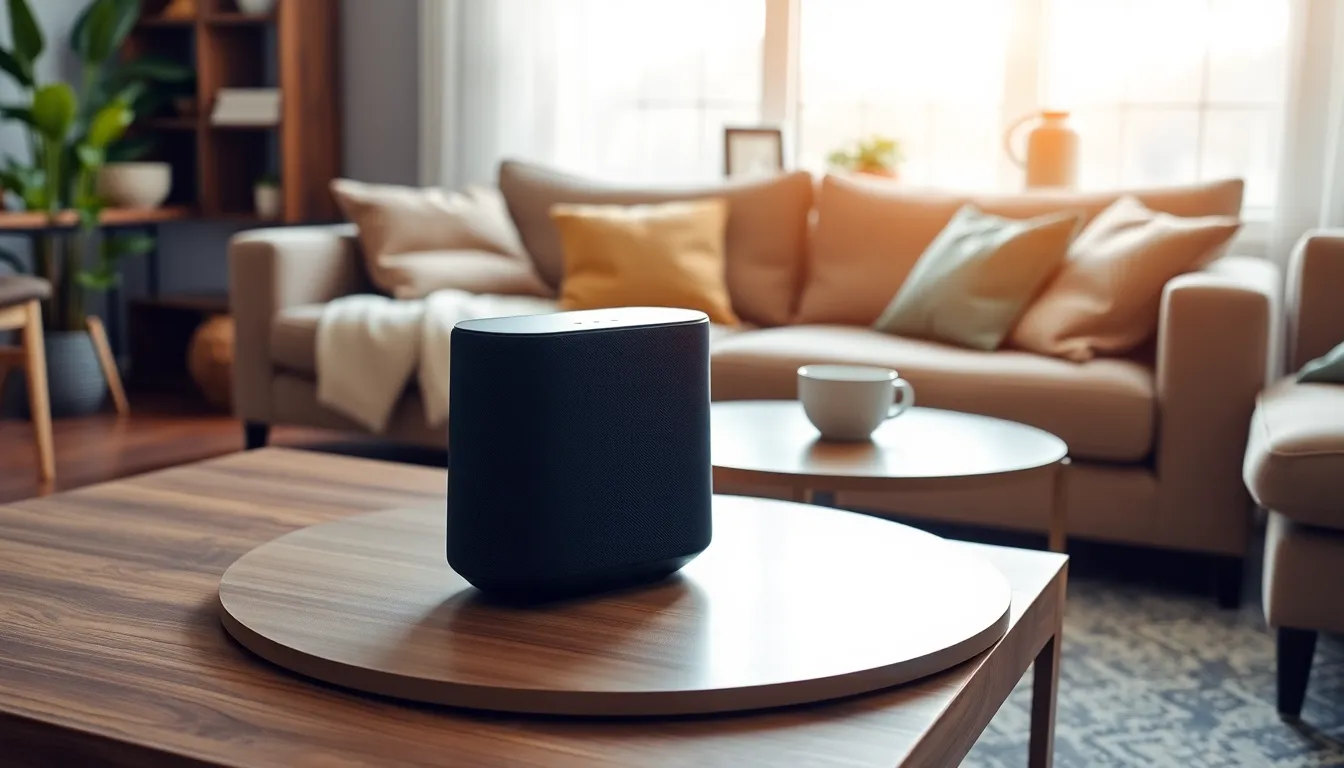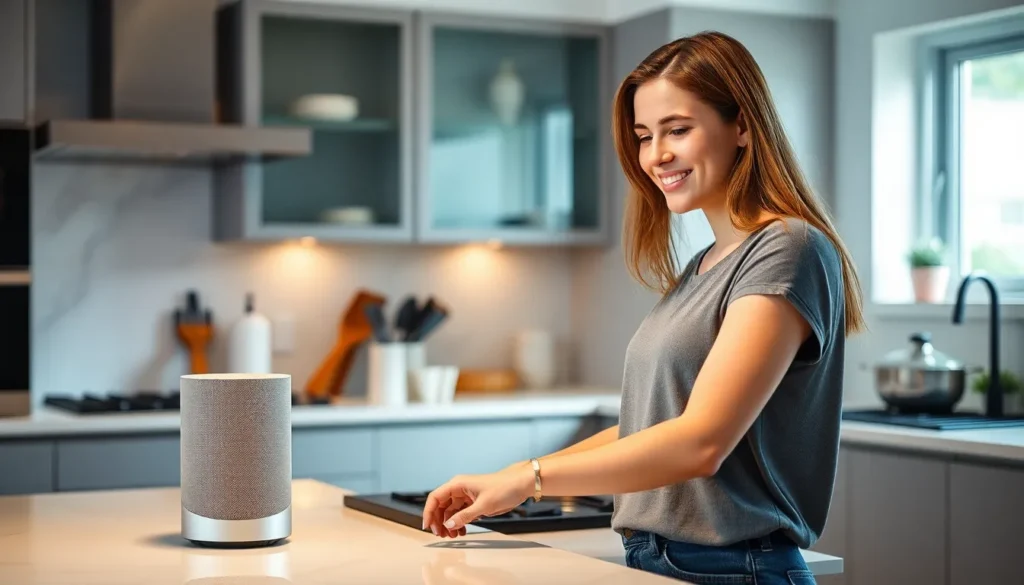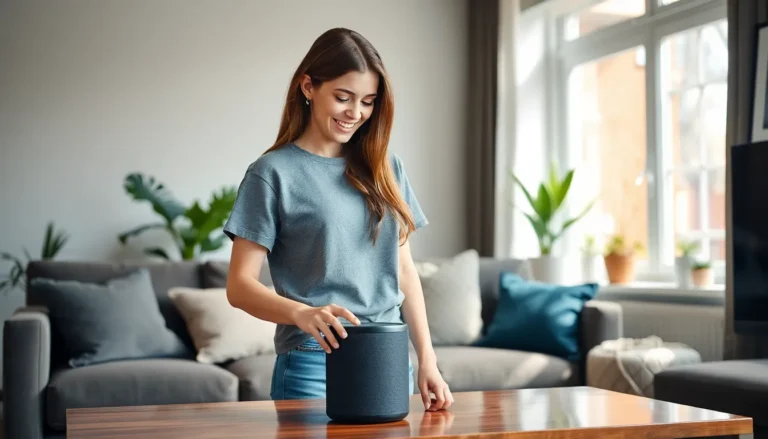In a world where asking a device to play your favorite song feels like magic, voice-controlled devices have become the modern-day genie—minus the three-wish limit. They’re not just gadgets; they’re companions that listen to your every whim, whether it’s turning off the lights or finding the perfect pizza recipe.
Table of Contents
ToggleOverview of Voice-Controlled Devices
Voice-controlled devices serve as essential tools in modern households. These gadgets utilize voice recognition technology to execute commands, making user interaction seamless and intuitive. Popular examples include smart speakers, virtual assistants, and connected home appliances, which allow users to manage various tasks hands-free.
Functionality centers around machine learning algorithms that improve over time. Users often find that these devices learn from interactions, enhancing responsiveness and accuracy. For instance, many devices can identify individual voices, tailoring responses based on user preferences.
Compatibility plays a crucial role in voice-controlled devices. Integration with smart home ecosystems enables greater functionality. Many devices connect with other smart appliances, creating a network for efficient home management. This interconnectedness allows users to control lights, thermostats, and security systems using simple voice commands.
The advantages of voice-controlled devices extend beyond convenience. Accessibility improves for individuals with mobility challenges, allowing them to perform commands without physical exertion. Additionally, voice-controlled devices often provide quick access to information, such as weather updates, news summaries, and traffic reports.
Security features also benefit users. Many devices incorporate encryption and authentication measures to protect personal data. As concerns about privacy grow, the importance of secure voice-controlled systems increases.
Overall, voice-controlled devices revolutionize the way users interact with technology. Their evolution indicates a shift toward more natural and efficient communication methods, highlighting their relevance in everyday life.
Types of Voice-Controlled Devices

Voice-controlled devices come in various forms, each serving unique functions that enhance daily life. Popular categories include smart speakers, voice assistants, and home automation systems.
Smart Speakers
Smart speakers act as multifunctional hubs for voice interaction. Devices like Amazon Echo and Google Nest Hub enable hands-free control of music, information retrieval, and smart home management. These gadgets integrate seamlessly with services like Spotify and Apple Music to provide instant access to audio content. Additionally, they support voice commands for tasks such as setting reminders and checking the weather. Smart speakers also engage with other smart devices in a home, allowing for streamlined control and interconnected experiences.
Voice Assistants
Voice assistants serve as powerful interfaces for managing tasks through voice commands. Examples include Siri, Alexa, and Google Assistant, which facilitate quick access to information and services. Users can ask questions, send messages, or control compatible devices using natural language. Each assistant learns and adapts to individual preferences over time, creating a personalized experience. Integration with smartphones and tablets enhances their versatility, allowing users to access features on the go. Moreover, these assistants improve accessibility by providing support for individuals with difficulties navigating traditional interfaces.
Home Automation Systems
Home automation systems revolutionize the way people interact with their living spaces. Devices such as smart thermostats, security cameras, and lighting systems connect through voice-controlled interfaces. By using platforms like SmartThings or Apple HomeKit, users can manage multiple devices from a single interface. Voice commands enable strategies for energy efficiency, comfort, and security, as users can adjust settings or monitor their homes remotely. This connectivity allows for the creation of customized automation routines, simplifying daily tasks and enhancing convenience in everyday living.
Benefits of Voice-Controlled Devices
Voice-controlled devices offer numerous advantages that enhance daily tasks and communication. These devices simplify interactions, making technology accessible to a broader range of users.
Convenience and Accessibility
Convenience stands out as a primary benefit of voice-controlled devices. Users can perform tasks with simple voice commands, from adjusting thermostats to playing music. Accessibility plays a crucial role, especially for individuals with mobility challenges. Voice control allows them to manage environments without physical strain. Additionally, hands-free operation enables users to multitask effectively, promoting efficiency in busy households. Voice recognition technology ensures prompt responses, which saves valuable time in various scenarios.
Enhanced User Experience
Enhanced user experience is another significant advantage associated with voice-controlled devices. Personalization options allow these devices to adapt to individual user preferences, creating a tailored interaction. Voice assistants respond to natural language, making communication feel intuitive and fluid. Users gain quick access to information, whether it’s asking for a weather update or setting reminders. Seamless integration with smart home ecosystems allows control of multiple devices, fostering an organized living space. Over time, machine learning algorithms improve responsiveness, ensuring a continually better interaction.
Challenges Faced by Voice-Controlled Devices
Voice-controlled devices face several challenges that impact user experience. These obstacles include privacy issues and concerns regarding accuracy and reliability.
Privacy Concerns
Privacy remains a significant concern for users of voice-controlled technology. Collecting and storing personal data raises questions about data protection and consent. Users worry about potential unauthorized access to their conversations, which creates distrust. The potential for data breaches or misuse also complicates the relationship between consumers and technology providers. Companies are addressing these issues by implementing encryption and privacy controls. However, continuous transparency about data usage is crucial for building user confidence.
Accuracy and Reliability
Accuracy and reliability significantly affect user satisfaction with voice-controlled devices. Misinterpretations of commands often lead to frustration, particularly in noisy environments. Users expect devices to understand various accents and dialects; however, limitations in voice recognition technology persist. Over time, machine learning improves performance, yet challenges remain. Calibration for individual voices and continuous updates can enhance accuracy. Developers focus on refining algorithms to manage complex commands better, ensuring a smoother interaction for users.
Future Trends in Voice-Controlled Devices
Artificial intelligence integration stands at the forefront of emerging trends in voice-controlled devices. By leveraging AI advancements, manufacturers aim to enhance understanding of complex queries, making interactions feel more natural and intuitive. Significant improvements are expected in devices’ capability to process context, with the goal of providing more relevant responses.
Greater emphasis on multilingual support is apparent as developers recognize the importance of inclusivity. Enhanced voice recognition technology will likely cater to diverse language speakers, promoting wider adoption in global markets. Users benefit from this inclusivity, as they can engage with devices in their native languages.
Increased focus on personalization also shapes the future landscape. Devices will use user behavioral data to tailor experiences around individual preferences, leading to more efficient task completion. Enhanced customization options promote higher levels of user satisfaction, aligning closely with their unique needs.
Data security concerns drive the demand for more robust privacy controls. As voice-controlled devices gather sensitive information, manufacturers prioritize encryption and user consent mechanisms. Transparency in data management fosters trust, enabling users to engage confidently with their devices.
Interoperability across smart home ecosystems ranks high on the list of upcoming trends. Consumers seek seamless interaction between various smart appliances and platforms. Efforts to standardize compatibility ensure that voice-controlled devices can work harmoniously, simplifying user management of multiple devices.
Greater integration of health monitoring features emerges as another trend. Sensors within voice-controlled devices could track health metrics and provide valuable insights, supporting users in their wellness journeys. This feature adds a layer of functionality, transforming how individuals approach health management.
Further developments in ambient computing promise a shift in how users interact with technology. Voice-controlled devices will become increasingly integrated into daily life, processing commands in the background without the need for conscious interaction. Such advancements transform seamless user experiences, reducing barriers to accessing technology.
Voice-controlled devices are reshaping how people interact with technology in their daily lives. Their ability to simplify tasks and enhance accessibility makes them invaluable in modern households. As these devices continue to evolve through advancements in artificial intelligence and machine learning, users can expect even more personalized and intuitive experiences.
Addressing privacy and reliability concerns will be crucial for fostering trust and ensuring user satisfaction. The future looks promising with ongoing improvements in multilingual support and interoperability across smart home ecosystems. Embracing these innovations will not only enhance convenience but also create a more connected and efficient living environment for everyone.




